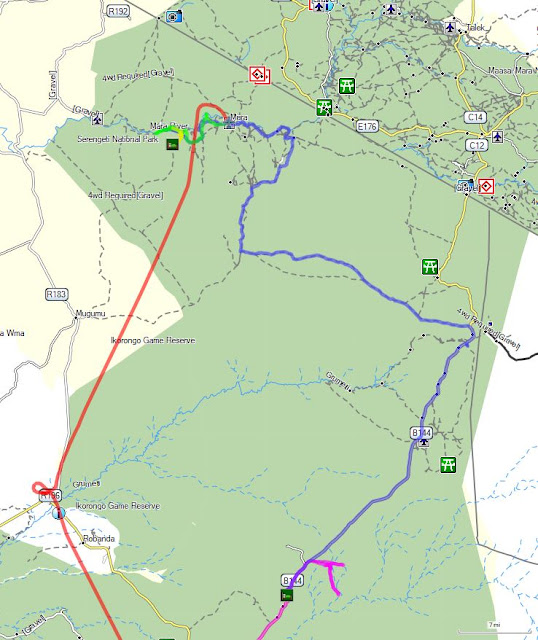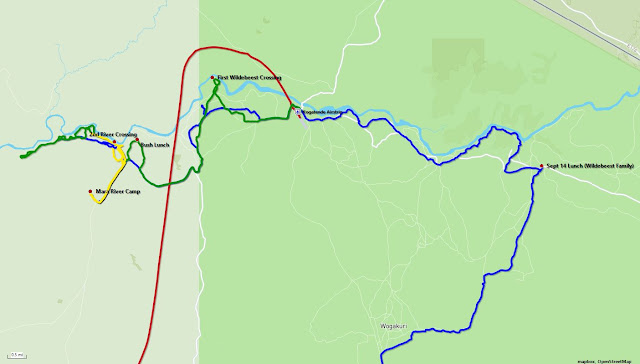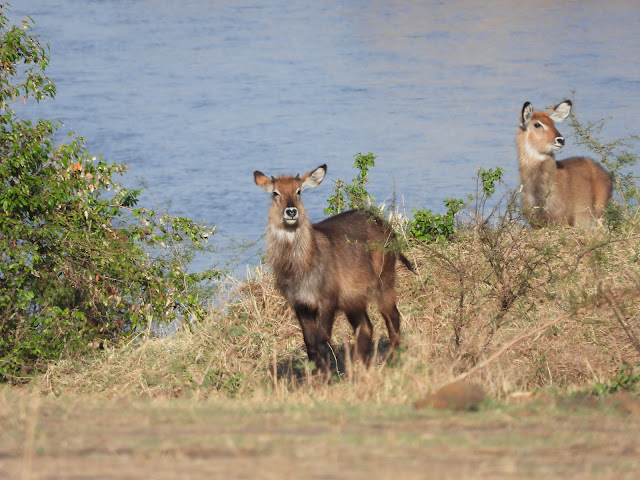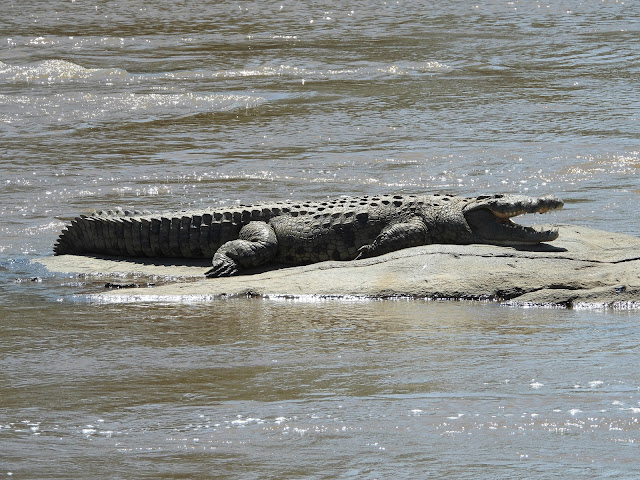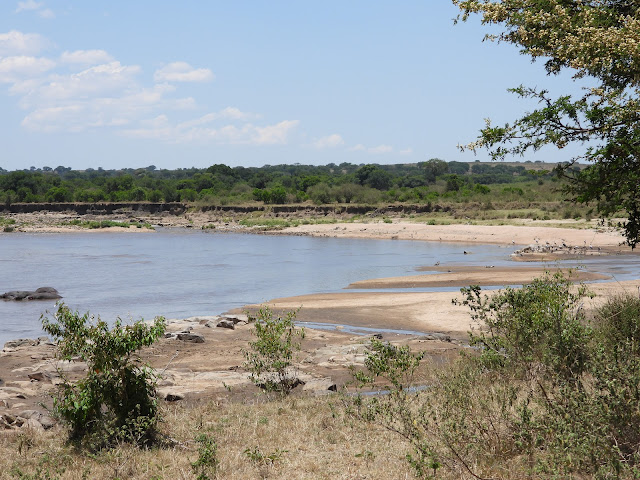[This is post #9 of 21 posts about our 2024 trip to Africa. To go to the first post in the series CLICK HERE. At the end of the last post there is also a Directory with links of all 21 posts.]
It was already well past our normal lunch time on Day 5, September 14, as we turned south away from the Mara River. As described in the previous post, it had been a busy morning filled with lots of wonderful animal sightings. However it was time to think about digging into our box lunches.
Water for the land animals. I assumed we would leave the water behind as we turned south. What I did not realize was that we would be following along or crossing over a couple of small tributaries to the Mara. They might be rivers during the rainy season, but since it was nearing the end of the dry season they were more like creeks.
These creeks had much gentler sloping banks and sandy or flat rock bottoms. All of the sand can be seen on the Google Earth image below taken in July, 2023, i.e. the dry season.
These creeks appeared to be a favorite watering site for a large number of zebra.
 |
| Zebra in the creek |
 |
| Zebra in one of the creeks |
Of course there were plenty hanging around in the grass nearby, including a mother and her foal shown below I don't know how old the foal might be, but probably less than a year. Although they begin to graze when only a few weeks old, they are not completely weaned until 7-11 months. Baby zebra also start off with mostly brown stripes. The one below certainly still has lots of brown.
 |
| Zebra foal getting lunch. |
As Fazal told us numerous times, zebra are quite cautious around watering holes. They know that it is where predators such as lions lie in wait for them. As seen in the video below, it almost looked like several of the zebra stayed back and took the role of look outs while others drank.
Warthog family. As we crossed over the larger creek on our way to some shade trees on the far bank we caught sight of a mother warthog and her baby next to the creek.
 |
| Momma and baby warthogs |
It is hard to think of warthogs as cute, but this little one running along behind his mother really was. Warthogs tend to trot when they move around, characteristically with their trail straight up like an antenna. I couldn't help but notice in the video below that this little one was already starting to do that.
I don't know how old this baby was. Baby warthogs are normally weaned by six months. This little one was clearly still nursing.
 |
| Lunchtime |
 |
| Four warthogs in this sounder, an adult female, a baby, and two juveniles. |
I am guessing the two "medium-size" ones were juveniles, since they did not have tusks.
 |
| I am guessing this is a juvenile since those are light-colored tufts of hair, not tusks. |
In any case the antics of this little group gave us something to watch as we sat in the safari vehicle on the bank above and dug into our box lunches. As with so many of the animals we had seen, they were certainly aware of our vehicle so close, but they totally ignored us.
Need to get moving. By the time we had finished lunch we needed to get moving. It was already nearly 2 pm and we had 75 miles yet to go to get to our new camp for the night, Mbuzi Mawe Serena Camp.
 |
| Our gps track for the day is in blue. Lunch was near the top of this map, just south of the Mara River. Mbuzi Mawe Serena Camp is the green square near the bottom. |
A distance of 75 miles doesn't seem like much but we only averaged 15 mph and hence it took us five hours. Admittedly we were slowed somewhat because we stopped when we saw something interesting. However the real reason was the rough road. All roads in the Serengeti are unpaved and all are rough. We rarely went over 20 or 25 mph and often went slower because it was just too rough.
Ostriches. Despite the long distance, we did not see a lot during our afternoon drive. We did see our first ostriches.
 |
| Pair of ostriches. The male (black feathers) is on the left. The female (gray feathers) is on the right. |
Ostriches almost always are together as a pair. The genders are different colors to provide maximum camouflage and hence maximum protection from predators. The male is much darker, since it sits on the nest a night. The female, which sits on the nest during the day, is a gray color.
 |
| Male ostrich |
They are so big and awkward looking. They did not seem like birds to me. I don't know how big this guy was, but Wiki says males stand nearly 7 up to 9 feet tall and weigh 220 to 290 lb. I never saw them moving any faster than a slow meander, but they can run for long distances at 34 mph. For short bursts they can go up to 60 mph! That is the fastest land speed of any bipedal animal and second only to Cheetahs for all land animals.
Elephants. We also encountered a group of elephants. We actually drove back off the road to get a better look at them.
They finally turned around toward us and flapped their ears. They were obviously not happy. They seemed to be saying "Enough already. Go away and leave us alone."
 |
| They turned facing us in unison and began flapping their ears. I think they were saying "Go away and leave us alone!" |
We did not want to bother them any further. We sat still and let them walk away.
Giraffes. We also saw several giraffes. Compared to some of the other animals, they seem so calm and laid back.
Dagga Boy - an old bull African Buffalo. We spotted a lone African Buffalo. Given the grey on his forehead and down his face, he was certainly an older fellow. He is what is often referred to as a "Dagga Boy".
 |
| Dagga Boy |
Older bulls cease to rejoin the herd when they can no longer compete with the younger, more aggressive males. These old bachelors are called dagga boys, which literally means "mud covered" since they often spend time wallowing in mud. These cantankerous old guys are not to be crossed. They are widely considered the most dangerous to humans
Getting Late. It was already nearly 6:30 pm by now. The sun was sinking rapidly in the west. We really needed to make it to our next camp since we are not supposed to be moving around in the park after dark. However, we couldn't pass up a couple of birds we saw along the road.
Secretarybird. We are not what most people would consider to be birders, but we do have some interest. One of the birds we had hoped to see on this trip was an unusual African bird, the Secretarybird.
 |
| Secretarybird |
It is a predator but is unusual with an eagle-like body and head on crane-like legs. It is very large. It stands over 4 feet high and has a wingspread of over 6 feet.
Unlike most birds of prey, the secretarybird is largely terrestrial, hunting its prey on foot. Prey ranges anywhere from grasshoppers to mammals the size of mongooses, although smaller mammals and reptiles are probably more common.
Kori Bustard. Next on our list of "hope to see birds" was the Kori Bustard. As luck would have it, there was one in the same field as the secretarybird.
 |
| Kori Bustard, reportedly the world's heaviest living flying animal |
The Kori Bustard is also a large bird. According to Wiki, a male Kori Bustard is 3.5 to 4.5 feet long with a wingspan of 7.5 to 9 feet. However it is its weight that is most noteworthy. Males in the Serengeti weigh on average 27 lb, but can range from 15 to 40 lb. This makes them the second largest bird in Africa behind the ostrich. However, unlike the ostrich, bustards can fly. That makes them what some believe is the heaviest flying animal living on earth. Between the ostrich, the secretarybird, and the Kori Bustard, we had seen quite the collection of "Big Birds" this afternoon.
Mbuzi Mawe Serena Camp. We finally made it to our new camp for the night, Mbuzi Mawe Serena Camp. However we made one more quick stop just short of the camp to catch yet another beautiful African sunset.
Mbuzi Mawe Serena Camp.was one of the more interesting camps on this trip for several reasons. First, the room had actual tent walls. We had to unzip the opening to enter
 |
| Our home for the night. The opening in the back is to the bathroom. |
Secondly, the camp is built on the side of one of the many kopjes, the granite outcroppings that are an iconic feature of the central Serengeti. Finally, we actually had some up close encounters with animals here All that and much more are the topic of the next post.







